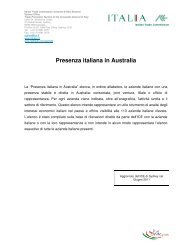Price Determination in the Australian Food Industry A Report
Price Determination in the Australian Food Industry A Report
Price Determination in the Australian Food Industry A Report
You also want an ePaper? Increase the reach of your titles
YUMPU automatically turns print PDFs into web optimized ePapers that Google loves.
PROCESSED FRUIT AND VEGETABLES<br />
Analysis of <strong>the</strong> determ<strong>in</strong>ants of prices and costs <strong>in</strong> product value cha<strong>in</strong>s<br />
PROCESSED FRUIT AND VEGETABLES – OVERVIEW<br />
Background<br />
The processed fruit and vegetable sector comprises frozen vegetables and t<strong>in</strong>ned fruit and<br />
vegetables. The processed fruit segment is 65 per cent of this sector by market share.<br />
The <strong>in</strong>dustry’s product mix<br />
This sector has <strong>the</strong> follow<strong>in</strong>g mix of products and markets.<br />
Figure 67. Share of fruit and vegetable product market<br />
o<strong>the</strong>r<br />
manufactur<strong>in</strong>g<br />
15%<br />
grocery<br />
40%<br />
export<br />
20%<br />
food service 25%<br />
Source: Ibisworld 2003e<br />
Grocery rema<strong>in</strong>s <strong>the</strong> major driver of returns as <strong>the</strong> market share held by <strong>the</strong> major retailers is<br />
very high.<br />
<strong>Price</strong> <strong>Determ<strong>in</strong>ation</strong> <strong>in</strong> <strong>the</strong> <strong>Australian</strong> <strong>Food</strong> <strong>Industry</strong> A <strong>Report</strong><br />
Major drivers of prices<br />
• Returns to processors and producers from <strong>the</strong> processed t<strong>in</strong>ned and frozen food products sector<br />
are strongly <strong>in</strong>fluenced by <strong>in</strong>ternational trade – with a significant percentage of imports (on<br />
average, 20 per cent) affect<strong>in</strong>g several major l<strong>in</strong>es.<br />
• Competition between companies is chiefly based on price, though companies have been striv<strong>in</strong>g<br />
to <strong>in</strong>crease <strong>the</strong> diversity of <strong>the</strong>ir product range offer<strong>in</strong>g to rema<strong>in</strong> attractive to retailers, to<br />
leverage brand position and to <strong>in</strong>crease capacity utilisation.<br />
• These food segments have suffered due to <strong>the</strong>ir traditional product nature and companies have<br />
been forced to <strong>in</strong>novate <strong>in</strong> several areas to <strong>in</strong>crease product appeal and relevance aga<strong>in</strong>st<br />
<strong>in</strong>creas<strong>in</strong>g demands for convenience and fresh foods.<br />
• Producers have been forced to operate for lengthy periods of time without price <strong>in</strong>creases due<br />
to <strong>the</strong> competitive pressure on processors and manufacturers.<br />
• At retail, locally produced processed food products are under pressure from a range of food<br />
<strong>in</strong>novations and market<strong>in</strong>g and promotional strategies <strong>in</strong> o<strong>the</strong>r sectors.<br />
• The major push by grocery retailers for a clean and fresh image, as well as policies of sourc<strong>in</strong>g<br />
processed products globally (where prices are competitive with locally supplied product), has<br />
limited sales and marg<strong>in</strong> growth for <strong>the</strong> processed food sector.<br />
66







